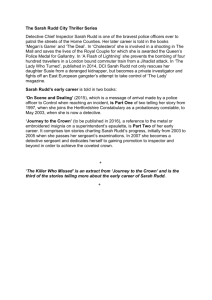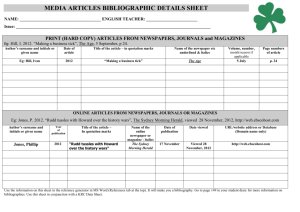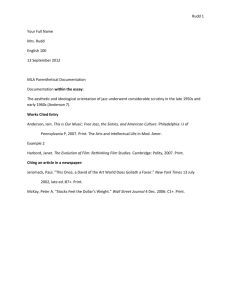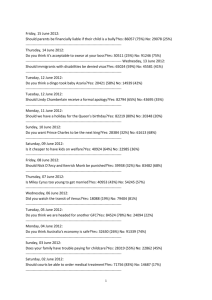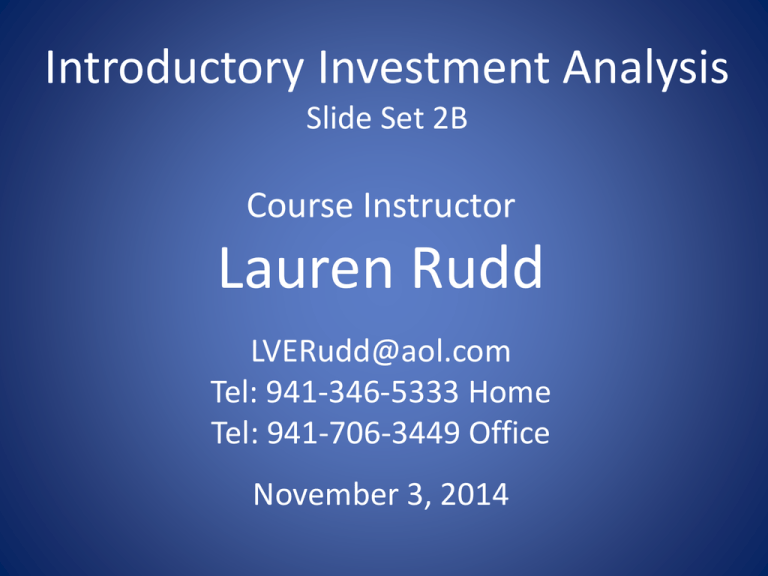
Introductory Investment Analysis
Slide Set 2B
Course Instructor
Lauren Rudd
LVERudd@aol.com
Tel: 941-346-5333 Home
Tel: 941-706-3449 Office
November 3, 2014
CAPM – Expected return
Capital Asset Pricing Model
r = Rf + beta x ( Rm - Rf ) where:
r = the expected rate return rate on a security
Rf = the rate of a "risk-free" investment
Rm = the return rate of the appropriate asset class
Beta measures the volatility of the security
relative to the asset class.
11/03/ 2014
© All Rights Reserved Rudd International
2
Expected Return
• The asset class for our purposes is the
market itself
• For calculation purposes we will use the
S&P 500 index
• The historical return on the S&P 500 is
11%
11/03/ 2014
© All Rights Reserved Rudd International
3
Expected Return
Risk free rate - is defined as a 10
year Treasury whose rate we
will assume to be 5%
11/03/ 2014
© All Rights Reserved Rudd International
4
Expected Return
r = Rf + beta x ( Rm - Rf )
Therefore:
r = 5 + beta x (11-5)
r = 5 + beta x 6
11/03/ 2014
© All Rights Reserved Rudd International
5
Expected Return
If a security is just as risky as the overall
market, investors would demand a
return of 11 percent
If a security is twice as risky as the
overall market, investors would
demand a return of 17 percent
11/03/ 2014
© All Rights Reserved Rudd International
6
Expected Return
• Betas are published by Merrill
Lynch, Value Line, S&P among
others
• Beta can be calculated with Excel
• It is the slope of a graph of stock
prices versus returns
11/03/ 2014
© All Rights Reserved Rudd International
7
Intrinsic Value - DDM
Dividend Discount Model
The Gordon growth model is a
variant of the Dividend Discount
Model using discounted cash flow
as a method for valuing a stock
See handout
11/03/ 2014
© All Rights Reserved Rudd International
8
Valuing a stock
• Assuming that the dividends will grow
forever at a constant growth rate g.
• The discount rate is k (can also be r)
• For constant perpetual dividend growth,
the DDM formula becomes:
D0 1 g
D1
P0
k g
k g
10/19/2010
11/03/ 2014
(Important : g k)
© All Rights Reserved Rudd International
9
Intrinsic Value – Disc. Earnings
Discounted Earnings Model
The easiest way to obtain an
intrinsic value using discounted
earnings is to log on to the web site:
www.Quicken.com
See Handout
11/03/ 2014
© All Rights Reserved Rudd International
10
Estimating the Growth Rate
The growth rate in dividends (g) can be
estimated in a number of ways:
• Using the company’s historical average growth
rate.
• Using an industry median or average growth
rate.
• Using the sustainable growth rate.
10/19/2010
11/03/
2014
© All Rights Reserved Rudd International
11
The Historical Average Growth Rate
• Suppose the Broadway Joe Company paid the following dividends:
– 2002: $1.50
– 2003: $1.70
– 2004: $1.75
•
The spreadsheet below shows how to estimate historical average growth rates,
using arithmetic and geometric averages.
Year:
2007
2006
2005
2004
2003
2002
10/19/2010
2005: $1.80
2006: $2.00
2007: $2.20
Dividend:
$2.20
$2.00
$1.80
$1.75
$1.70
$1.50
Pct. Chg:
10.00%
11.11%
2.86%
2.94%
13.33%
Arithmetic Average:
8.05%
Geometric Average:
7.96%
Year:
2002
2003
2004
2005
2006
2007
Grown at
7.96%:
$1.50
$1.62
$1.75
$1.89
$2.04
$2.20
© All Rights Reserved Savannah Capital Management
12
The Sustainable Growth Rate
Sustainabl e Growth Rate ROE Retention Ratio
ROE (1 - Payout Ratio)
• Return on Equity (ROE) = Net Income / Equity
• Payout Ratio = Proportion of earnings paid out as
dividends
• Retention Ratio = Proportion of earnings retained
for investment
10/19/2010
11/03/
2014
© All Rights Reserved Rudd International
13
Calculating Sustainable Growth Rate
• A company has an ROE of 10.17%, projected earnings per
share of $2.25, and a dividend of $1.56. What is the:
– Retention rate?
– Sustainable growth rate?
• Payout ratio = $1.56 / $2.25 = .693
• So, retention ratio = 1 – .693 = .307 or 30.7%
• Therefore, sustainable growth rate = .1017 .307 = .03122, or
3.122%
10/19/2010
11/03/
2014
© All Rights Reserved Rudd International
14
Using the Sustainable Growth Rate
What is the value of the stock, using the
perpetual growth model, and a discount
rate of 6.7%?
P0
10/19/2010
11/03/
2014
$1.56 1.03122
$44.96
.067 .03122
© All Rights Reserved Rudd International
15
The Two-Stage Dividend Growth Model
• The two-stage dividend growth model
assumes that a firm will initially grow at a rate
g1 for T years
• There after grow at a rate g2 < k during a
perpetual second stage of growth.
• The Two-Stage Dividend Growth Model
formula is:
T
T
D 0 (1 g1 ) 1 g1 1 g1 D 0 (1 g2 )
P0
1
k g1 1 k 1 k
k g2
10/19/2010
11/03/ 2014
© All Rights Reserved Rudd International
16
Two-Stage Dividend Growth Model
• Although the formula looks complicated, think of it as
two parts:
– Part 1 is the present value of the first T dividends (it is the
same formula we used for the constant growth model).
– Part 2 is the present value of all subsequent dividends.
• So, suppose MissMolly.com has a current dividend of
D0 = $5, which is expected to shrink at the rate, g1 =
10% for 5 years, but grow at the rate, g2 = 4% forever.
• With a discount rate of k = 10%, what is the present
value of the stock?
10/19/2010
11/03/
2014
© All Rights Reserved Rudd International
17
Two-Stage Dividend Growth Model
T
T
D 0 (1 g1 ) 1 g1 1 g1 D 0 (1 g 2 )
P0
1
k g1 1 k 1 k
k g2
$5.00(0.90 ) 0.90
P0
1
0.10 ( 0.10) 1 0.10
5
0.90 5 $5.00(1 0.04)
1
0.10
0.10 0.04
$14.25 $31.78
$46.03.
• The total value of $46.03 is the sum of a $14.25 present value
of the first five dividends, plus a $31.78 present value of all
subsequent dividends.
10/19/2010
11/03/
2014
© All Rights Reserved Rudd International
18
Discount Rates for DDM
The discount rate is estimated using
the capital asset pricing model
(CAPM )
10/19/2010
11/03/
2014
© All Rights Reserved Rudd International
19
Dividend Discount Models
Constant Perpetual Growth Model:
•
•
•
•
•
•
Simple to compute
Not usable for firms that do not pay dividends
Not usable when g > k
Is sensitive to the choice of g and k
k and g may be difficult to estimate accurately.
Constant perpetual growth is often an unrealistic
assumption.
10/19/2010
11/03/ 2014
© All Rights Reserved Rudd International
20
Dividend Discount Models
Two-Stage Dividend Growth Model:
• More realistic in that it accounts for two
stages of growth
• Usable when g > k in the first stage
• Not usable for firms that do not pay dividends
• Is sensitive to the choice of g and k
• k and g may be difficult to estimate accurately.
10/19/2010
11/03/
2014
© All Rights Reserved Rudd International
21
Dividend Discount Models
• Utilize the small Excel program
• See handout
• Required data:
– First stage growth rate
– Second stage growth rate
– First stage discount rate
– Second stage discount rate
11/03/ 2014
© All Rights Reserved Rudd International
22
Discounted Earnings Model
• Uses the same principles as the DDM
• See handout for small Excel model
• Same model but with less flexibility is
available at Investing.Quicken.com
• Inputs same as DDM plus Long Term Debt and
Shares outstanding
• Uses earnings instead of dividends as cash
flow
11/03/ 2014
© All Rights Reserved Rudd International
23
Intrinsic Value - FCFF
Definitions
• Operating Expenses = CGS + SG&A + R&D
• Net Operating Profit (NOP) = Operating
Revenues – Operating Expenses
• Net Operating Profit Margin =
NOP/Revenue
11/03/ 2014
© All Rights Reserved Rudd International
24
Intrinsic Value - FCFF
Definitions cont.
• Net Investment = New Investment –
Depreciation
• Working Capital = Acc’t Rec + Inventories
– Acct’s Payable
11/03/ 2014
© All Rights Reserved Rudd International
25
Intrinsic Value - FCFF
FCFF - the cash that is left over after
payment of all hard cash expenses
and all operating investment
FCFF = NOP – Taxes – Net Inv – Net
Change in Working Capital
11/03/ 2014
© All Rights Reserved Rudd International
26
Intrinsic Value - FCFF
Four Step Process
• Forecast Expected Cash Flows
• Estimate the WACC (weighted average
cost of capital)
• Calculate Enterprise (Corporate) Value
• Calculate Intrinsic Value
11/03/ 2014
© All Rights Reserved Rudd International
27
FCCF Model
The easiest way to obtain an
intrinsic value using free cash
flow to the firm is to log on to
the web site:
www.ValuePro.net
See Handout
11/03/ 2014
© All Rights Reserved Rudd International
28
Residual Income Model
• We have valued only companies that pay dividends.
– But, there are many companies that do not pay dividends.
– What about them?
– It turns out that there is an elegant way to value these
companies, too.
• The model is called the Residual Income Model (RIM).
•
Major Assumption (known as the Clean Surplus Relationship, or
CSR): The change in book value per share is equal to earnings per
share minus dividends.
10/19/2010
11/03/
2014
© All Rights Reserved Rudd International
37
Residual Income Model
• Inputs needed:
– Earnings per share at time 0, EPS0
– Book value per share at time 0, B0
– Earnings growth rate, g
– Discount rate, k
• There are two equivalent formulas for the Residual Income Model:
P0 B 0
EPS0 (1 g) B 0 k
kg
or
P0
10/19/2010
EPS1 B 0 g
kg
BTW, it turns out that the
RIM is mathematically the
same as the constant
perpetual growth model.
© All Rights Reserved Savannah Capital Management
38
Using the Residual Income Model
• Superior Offshore International, Inc. (DEEP)
• It is July 1, 2007—shares are selling in the market for $10.94.
• Using the RIM:
– EPS0 = $1.20
– DIV = 0
EPS0 (1 g) B 0 k
– B0 = $5.886
P0 B 0
kg
– g = 0.09
– k = .13
$1.20 (1 .09) $5.886 .13
P0 $5.886
• What can we say
about the market
price of DEEP?
10/19/2010
P0 $5.886
.13 .09
$1.308 $.7652
$19.46.
.04
© All Rights Reserved Savannah Capital Management
39
DEEP Growth
• Using the information from the previous slide, what growth
rate results in a DEEP price of $10.94?
P0 B 0
EPS 0 (1 g) B 0 k
kg
$10.94 $5.886
$1.20 (1 g) $5.886 .13
.13 g
$5.054 (.13 g) 1.20 1.20g .7652
$.6570 5.054g 1.20g .4348
.2222 6.254g
g .0355 or 3.55%.
10/19/2010
© All Rights Reserved Savannah Capital Management
32
Price Ratio Analysis
• Price-earnings ratio (P/E ratio)
– Current stock price divided by annual earnings per
share (EPS)
• Earnings yield
– Inverse of the P/E ratio: earnings divided by price (E/P)
• High-P/E stocks are often referred to as growth
stocks, while low-P/E stocks are often referred to
as value stocks.
10/19/2010
11/03/
2014
© All Rights Reserved Rudd International
33
Price Ratio Analysis
• Price-cash flow ratio (P/CF ratio)
– Current stock price divided by current cash flow per
share
– In this context, cash flow is usually taken to be net
income plus depreciation.
• Most analysts agree that in examining a
company’s financial performance, cash flow can
be more informative than net income.
• Earnings and cash flows that are far from each
other may be a signal of poor quality earnings.
10/19/2010
11/03/
2014
© All Rights Reserved Rudd International
34
Price Ratio Analysis
• Price-sales ratio (P/S ratio)
– Current stock price divided by annual sales per share
– A high P/S ratio suggests high sales growth, while a
low P/S ratio suggests sluggish sales growth.
• Price-book ratio (P/B ratio)
– Market value of a company’s common stock divided
by its book (accounting) value of equity
– A ratio bigger than 1.0 indicates that the firm is
creating value for its stockholders.
10/19/2010
11/03/
2014
© All Rights Reserved Rudd International
35
Price/Earnings Analysis - Intel
Intel Corp (INTC) - Earnings (P/E) Analysis
5-year average P/E ratio
Current EPS
EPS growth rate
27.30
$.86
8.5%
Expected stock price = historical P/E ratio
projected EPS
$25.47 = 27.30 ($.86 1.085)
stock price at the time was $24.27
10/19/2010
11/03/
2014
© All Rights Reserved Rudd International
36
Price/Cash Flow - Intel
Intel Corp (INTC) - Cash Flow (P/CF) Analysis
5-year average P/CF ratio
Current CFPS
CFPS growth rate
14.04
$1.68
7.5%
Expected stock price = historical P/CF ratio
projected CFPS
$25.36 = 14.04 ($1.68 1.075)
stock price at the time was $24.27
10/19/2010
11/03/
2014
© All Rights Reserved Rudd International
37
Price/Sales - Intel
Intel Corp (INTC) - Sales (P/S) Analysis
5-year average P/S ratio
Current SPS
SPS growth rate
4.51
$6.14
7%
Expected stock price = historical P/S ratio
projected SPS
$29.63 = 4.51 ($6.14 1.07)
stock price at the time was $24.27
10/19/2010
11/03/
2014
© All Rights Reserved Rudd International
38
An Analysis of McGraw-Hill
The next few slides contain a financial
analysis of the McGraw-Hill Company,
using data from the Value Line
Investment Survey.
10/19/2010
11/03/
2014
© All Rights Reserved Rudd International
39
10/19/2010
11/03/
2014
© All Rights Reserved Rudd International
40
41
10/19/2010
11/03/
2014
© All Rights Reserved Rudd International
41
McGraw-Hill
• Based on the CAPM, k = 3.1% + (.80 9%) =
10.3%
• Retention ratio = 1 – $.66/$2.65 = .751
• Sustainable g = .751 23% = 17.27%
• Because g > k, the constant growth rate model
cannot be used. (We would get a value of $11.10 per share)
10/19/2010
11/03/
2014
© All Rights Reserved Rudd International
42
McGraw-Hill – residual income
•
Let’s assume that “today” is January 1, 2008, g = 7.5%, and k = 12.6%.
•
Using the Value Line Investment Survey (VL), we can fill in column two (VL) of the
table below.
•
We use column one and our growth assumption for column three (CSR) of the
table below.
End of 2007
2008 (VL)
NA
$6.50
$6.50
EPS
$3.05
$3.45
$3.2788
DIV
$.82
$.82
$2.7913
Ending BV per share
$6.50
$9.25
$6.9875
Beginning BV per share
2008 (CSR)
3.05 1.075 6.50 1.075
" Plug" 3.2788 - (6.9875 - 6.50)
10/19/2010
© All Rights Reserved Savannah Capital Management
43
McGraw-Hill – residual income
•
Using the CSR assumption:
P0 B 0
EPS 0 (1 g) B 0 k
kg
P0 $6.50
Stock price at the time = $57.27.
What can we say?
•
Using Value Line numbers for
EPS1=$3.45, B1=$9.25
B0=$6.50; and using the actual change
in book value instead of an estimate
of the new book value, (i.e., B1-B0 is =
B0 x k)
$3.05 (1 .075) $6.50 .126
.126 .075
P0 $54.73.
P0 B 0
EPS0 (1 g) B 0 k
kg
P0 $6.50
$3.45 ($9.25 - 6.50)
.126 .075
P0 $20.23
10/19/2010
© All Rights Reserved Savannah Capital Management
44
McGraw-Hill Price - Ratio
10/19/2010
11/03/
2014
© All Rights Reserved Rudd International
45
Valuing a stock
Collect the data you will need:
•
•
•
•
•
•
Sustainable growth rate
Expected growth rate
Estimated growth rate
Discount rate
Beta
Risk free rate of return
11/03/ 2014
© All Rights Reserved Rudd International
46
Valuing a stock
Financial ratios you will need:
•
•
•
•
•
•
•
Price/share
Earnings/share
Cash flow/share
Sales/share
Price/earnings
Price/sales
Price/cash flow
11/03/ 2014
© All Rights Reserved Rudd International
47
Valuing a stock
Intrinsic Value Models:
•
•
•
•
•
Discounted Earnings
Discounted Free Cash Flow to the Firm
Dividend Discount Model
Residual Income Model
Price Ratio Analysis
11/03/ 2014
© All Rights Reserved Rudd International
48

